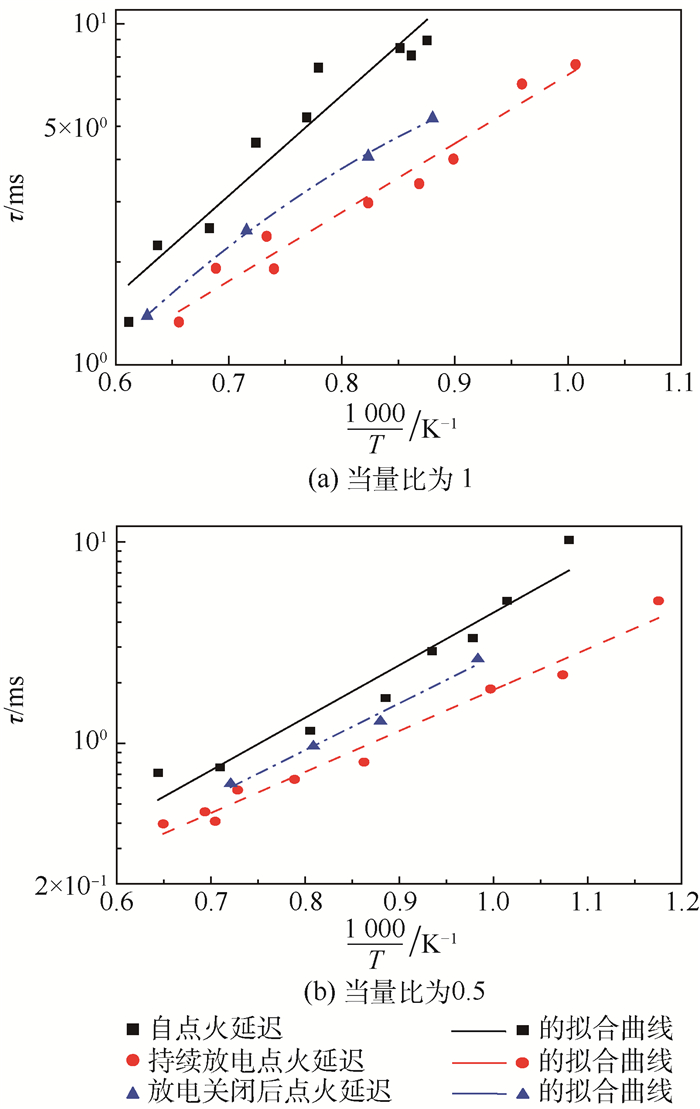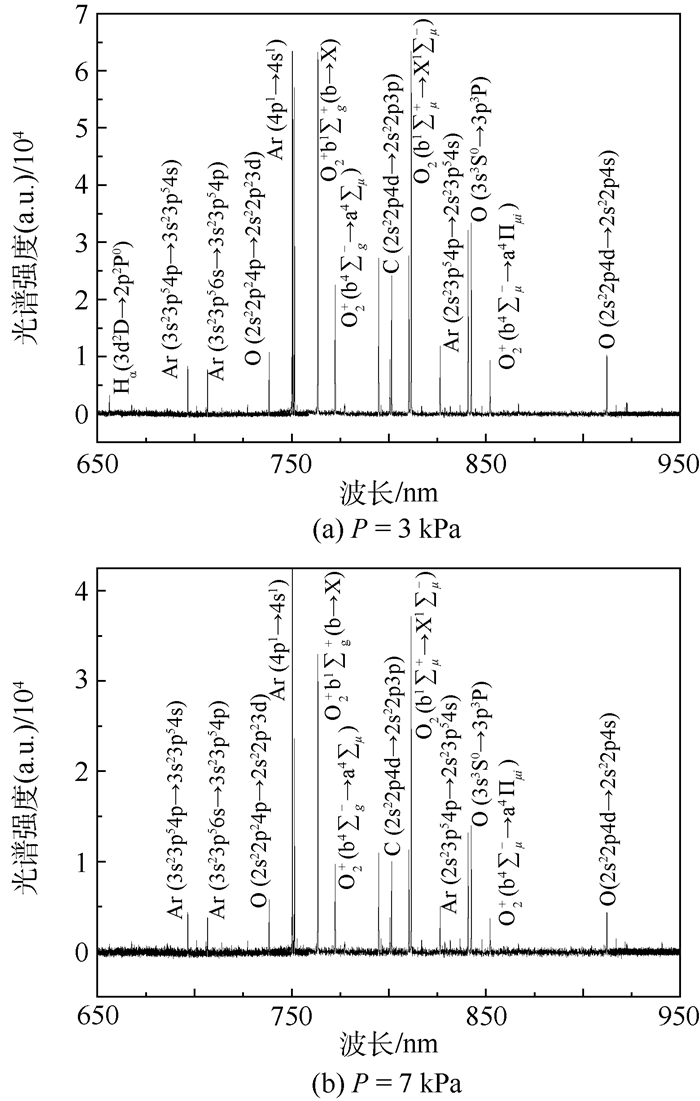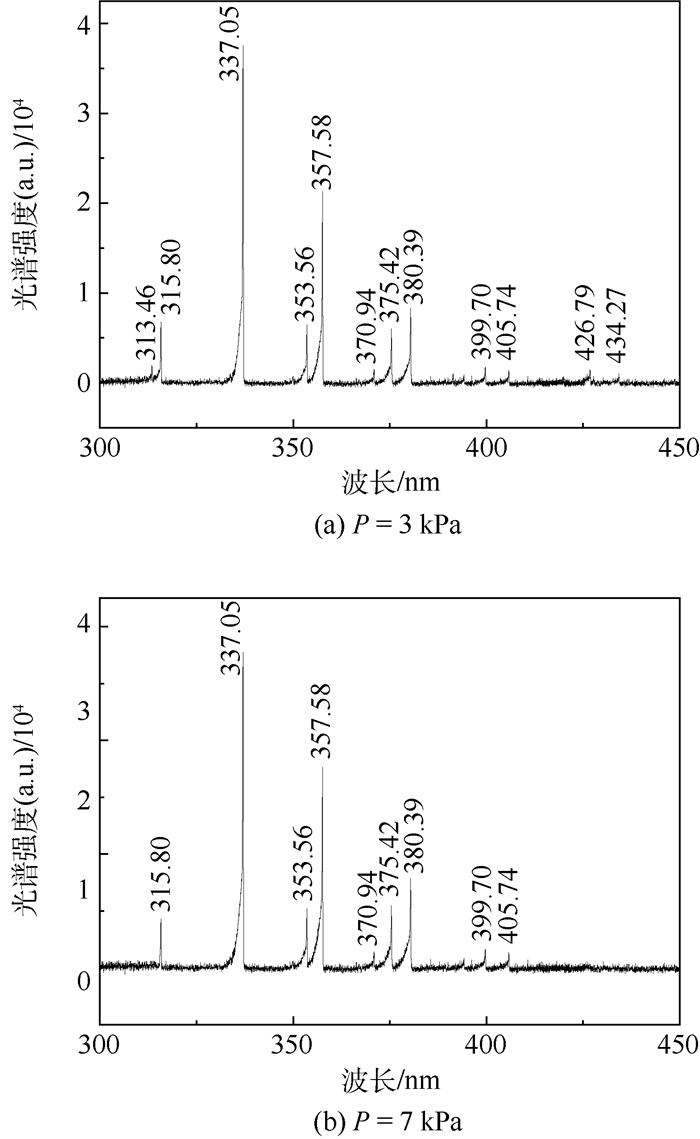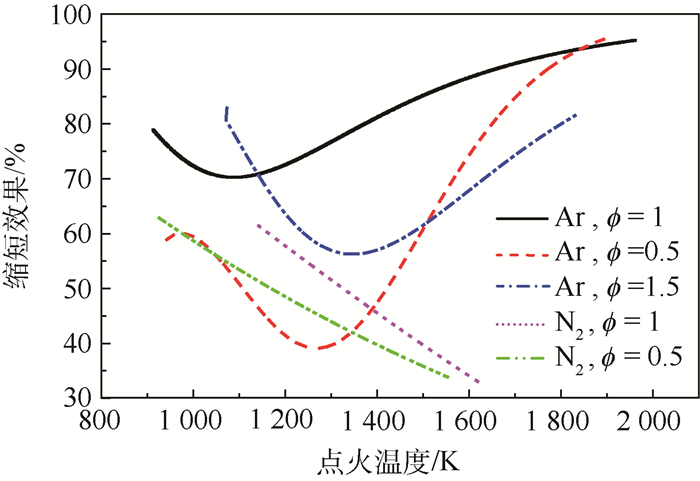-
摘要:
等离子体由于可以同时在燃料反应中增加化学效应与热效应,有望成为辅助点火的有效技术途径。构建了基于激波管的等离子体辅助甲烷点火实验系统,测量了甲烷自点火、持续放电以及放电后断电条件下的点火延迟时间,分析了不同稀释气体下等离子体对甲烷点火延迟的缩短效果。构建了等离子体发射光谱测量系统,测量了放电单元中的发射光谱。在实验条件下,点火温度越高,持续放电下活性粒子的浓度越高。较小的放电功率( < 4 W)即可将甲烷的点火延迟时间缩短30%~95%。稀释气体为Ar时,等离子体在点火温度小于1 000 K或大于1 400 K时对甲烷点火延迟时间缩短作用更好。稀释气体为N2时,随着点火温度的升高,等离子体对甲烷点火延迟时间作用效果随之降低。
Abstract:Plasma could increase chemical and heat effect at the same time during the fuel reaction and it is expected to be an effective technical way of ignition assistance. Plasma assisted methane ignition experiment system was built based on shock tube. The methane ignition delay time of autoignition, under continuous discharge and when discharge is cut down was measured. The plasma's effect to shorten methane ignition delay under different diluent gas was analyzed. The plasma emission spectrum measurement system was built and the emission spectrum in discharge unit was measured. The active particle concentration is higher with higher ignition temperature under experimental condition. The methane ignition delay time could be shortened by 30% to 95% by a little discharge power ( < 4 W). The shortening effect of plasma is better when the ignition temperature is lower than 1 000 K or higher than 1 400 K with the diluent gas Ar. The shortening effect of plasma decreases with the increase of ignition temperature with the diluent gas N2.
-
Key words:
- plasma /
- shock tube /
- ignition delay /
- diluent gas /
- emission spectrum
-
表 1 当量比为1的不同稀释气体甲烷点火延迟时间拟合对比
Table 1. Fitting comparison of methane ignition delay time of equivalent ratio equals to 1 under different diluent gas
稀释气体 拟合参数 拟合值 拟合确定系数 Ar a -3.8221 0.9785 b 5.2165 N2 a -1.5697 0.9175 b 2.9495 表 2 当量比为1的不同稀释气体在持续放电条件下甲烷点火延迟时间拟合对比
Table 2. Fitting comparison of methane ignition delay time of equivalent ratio equals to 1 in different diluent gas under continuous discharge
稀释气体 拟合线型 拟合曲线 Ar 二次函数 ln τ=-14.279 56+25.365 9(1000/T)-10.9474(1000/T)2 N2 一次函数 ln τ=-2.6947+4.6531(1000/T) -
[1] XU B, SHI Z K.An overview on flight dynamic and control approaches for hypersonic vehicles[J]. Science China Information Sciences, 2015, 58(7):070201. [2] 丁猛, 余勇, 梁剑寒, 等.碳氢燃料超燃冲压发动机点火技术试验[J].推进技术, 2004, 25(6):566-569. http://www.cnki.com.cn/Article/CJFDTOTAL-TJJS200904000.htmDING M, YU Y, LIANG J H, et al.Experimental investigation of ignition technology in liquid hydrocarbon fueled scramjet combustor[J]. Journal of Propulsion Technology, 2004, 25(6):566-569(in Chinese). http://www.cnki.com.cn/Article/CJFDTOTAL-TJJS200904000.htm [3] STARIKOVSKIY A, ALEKSANDROV N.Plasma-assisted ignition and combustion[J]. Progress in Energy and Combustion Science, 2013, 39(1):61-110. doi: 10.1016/j.pecs.2012.05.003 [4] JU Y G, SUN W T.Plasma assisted combustion:Dynamics and chemistry[J]. Progress in Energy and Combustion Science, 2015, 48:21-83. doi: 10.1016/j.pecs.2014.12.002 [5] GUNDERSEN M.Energy-efficient transient plasma ignition and combustion:No.F49620-01-1-0322[R].[S.l.]:AFOSR, 2004. [6] KOSAREV I N, ALEKSANDROV N L, KINDYSHEVA S M, et al.Kinetic mechanism of plasma-assisted ignition of hydrocarbons[J]. Journal of Physics D: Applied Physics, 2008, 41(3):032002. doi: 10.1088/0022-3727/41/3/032002 [7] KOSAREV I N, PAKHOMOV A I, KINDYSHEVA S V, et al.Nanosecond discharge ignition of lean C2H2-containing mixture:AIAA-2013-1050[R]. Reston:AIAA, 2013. [8] KOSAREV I N, PAKHOMOV A I, KINDYSHEVA S V, et al.Nanosecond discharge ignition in acetylene-containing mixtures[J]. Plasma Source Science and Technology, 2013, 22(4):447-450. [9] KOSAREV I N, ALEKSANDROV N L, KINDYSHEVA S V, et al.Kinetics of ignition of saturated hydrocarbons by nonequilibrium plasma:C2H6-to C5H12-containing mixtures[J]. Combustion and Flame, 2009, 156(1):221-233. doi: 10.1016/j.combustflame.2008.07.013 [10] KOSAREV I N, ALEKSANDROV N L, KINDYSHEVA S V, et al.Kinetic mechanism of plasma-assisted ignition of hydrocarbons[J]. Journal of Physics D:Applied Physics, 2008, 41(3):295-302. doi: 10.2514/6.2008-5068 [11] BOUMEHDI M A, STEPANYAN S A, DESGROUX P, et al.Ignition of methane-and n-butane-containing mixtures at high pressures by pulsed nanosecond discharge[J]. Combustion and Flame, 2014, 162(4):1336-1349. [12] KIMURA I, AOKI H, KATO M.The use of a plasma jet for fame stabilization and promotion of combustion in supersonic air flows[J]. Combust and Flame, 1981, 42:297-305. doi: 10.1016/0010-2180(81)90164-4 [13] JACOBSEN L S, CARTER C D, BAURLE R A, et al.Plasma-assisted ignition in scramjets[J]. Journal of Propulsion and Power, 2008, 24(4):641-654. doi: 10.2514/1.27358 [14] MASUYA G, TAKITA K, TAKAHASHI K, et al.Effects of airstream mach number on H/N plasma igniter[J]. Journal of Propulsion and Power, 2002, 18(3):679-685. doi: 10.2514/2.5984 [15] TAKITA K, ABE N, MASUYA G, et al.Ignition enhancement by addition of NO and NO2, from a N2/O2, plasma torch in a supersonic flow[J]. Proceedings of the Combustion Institute, 2007, 31(2):2489-2496. doi: 10.1016/j.proci.2006.07.108 [16] 杜洪亮, 何立明, 兰宇丹, 等.约化场强对氮-氧混合气放电等离子体演化特性的影响[J].物理学报, 2011, 60(11):115201. doi: 10.7498/aps.60.115201DU H L, HE L M, LAN Y D, et al.Influence of reduced electric field on the evolvement characteristics of plasma under conditions of N2/O2 discharge[J]. Acta Physica Sinica, 2011, 60(11):115201(in Chinese). doi: 10.7498/aps.60.115201 [17] 韦宝禧, 欧东, 闫明磊, 等.超燃燃烧室等离子体点火和火焰稳定性能[J].北京航空航天大学学报, 2012, 38(12):1572-1576.WEI B X, OU D, YAN M L, et al.Ignition and flame holding ability of plasma torch igniter in a supersonic flow[J]. Journal of Beijing University of Aeronautics and Astronautics, 2012, 38(12):1572-1576(in Chinese). [18] 张鹏, 洪延姬, 丁小雨, 等.等离子体对含硼两相流扩散燃烧特性的影响[J].物理学报, 2015, 64(20):205203. doi: 10.7498/aps.64.205203ZHANG P, HONG Y J, DING X Y, et al.Effect of plasma on boron-based two-phase flow diffusion combustion[J]. Acta Physica Sinica, 2015, 64(20):205203(in Chinese). doi: 10.7498/aps.64.205203 [19] KIM K, SHIN K S.Shock tube and modeling study of the ignition of propane[J]. Bulletin-Korean Chemical Society, 2001, 22(3):303-307. [20] VRIES J D, HALL J M, SIMMONS S L, et al.Ethane ignition and oxidation behind reflected shock waves[J]. Combustion and Flame, 2007, 150(1):137-150. [21] 沈双晏, 金星, 张鹏.甲烷-空气混合气体放电等离子体增强点火机理分析[J].推进技术, 2015, 36(10):1509-1515. http://www.cnki.com.cn/Article/CJFDTOTAL-TJJS201510009.htmSHEN S Y, JIN X, ZHANG P.Analysis on mechanism of plasma enhanced ignition of methane-air discharge[J]. Journal of Propulsion Technology, 2015, 36(10):1509-1515(in Chinese). http://www.cnki.com.cn/Article/CJFDTOTAL-TJJS201510009.htm [22] DAVIDSON D F, HANSON R K.Interpreting shock tube ignition data[J]. International Journal of Chemical Kinetics, 2004, 36(9):510-523. doi: 10.1002/(ISSN)1097-4601 [23] 张百灵, 王宇天, 李益文, 等.低气压直流辉光放电数值模拟与实验研究[J].高电压技术, 2016, 42(3):724-730. http://www.cnki.com.cn/Article/CJFDTOTAL-GDYJ201603005.htmZHANG B L, WANG Y T, LI Y W, et al.Numerical simulation and experimental study for low-pressure direct-current glow discharge[J]. High Voltage Engineering, 2016, 42(3):724-730(in Chinese). http://www.cnki.com.cn/Article/CJFDTOTAL-GDYJ201603005.htm -








 下载:
下载:








